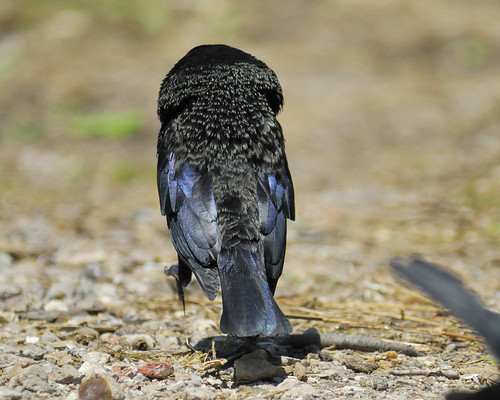tags: Bronzed Cowbird, Molothrus aeneus, birds, mystery bird, bird ID quiz
[Mystery bird] Bronzed Cowbird, Molothrus aeneus, photographed at Quintana, Brazoria County, Texas. [I will identify these birds for you in 48 hours]
Image: Joseph Kennedy, 22 April 2009 [larger view].
Nikon D200, Kowa 883 telescope with TSN-PZ camera eyepiece 1/800s f/8.0 at 1000.0mm iso400.
Please name at least one field mark that supports your identification.


Male Bronzed Cowbird, based on the overall glossy black plumage and the "mane."
hmmm, I'll wait for more to have a go, but I just watched a mixed flock of about 60 of their eastern cousins along with even bigger bully-boy grackles beat up on the sparrows and juncos in my garden!
It looks like an Icterid and the glossy plumage suggests a Cowbird. The description of Bronzed says it has a distinctive ruffed appearance so with my limited experience of this group I agree with Sheri. For David I think it is probably the nominate M. a. aenus until you tell us different!
Yeah, I'll vote for Bronzed Cowbird male as well. I wouldn't have known it, except for playing with http://cone.berkeley.edu/.
LOL Adrian, yep, I would agree- although both US subspecies overlap in western Texas, Brazoria County is certainly the eastern population... this is definitely a male Bronzed Cowbird, Molothrus aeneus aeneus: irridescent plumage ranging from dark blue through green to bronze; black legs; and the distinctive black ruff; if we could see his eyes, they would be bright red...
Indeed, two of the four subspecies are found in the US, aeneus is found in Texas and south along the east coast of Mexico, (and although not listed in many distribution ranges, I have found records of aeneus in Louisiana) and loyei is found in extreme southeast California, Arizona, New Mexico, and northwest Mexico... (Bronze Cowbirds are also found from El Salavador through Costa Rica then Panama to Colombia)
The eastern cousins to which I alluded this morning are the Brown-headed Cowbirds, Molothrus ater, recorded as successfully parasitizing about 150 different species whereas the Bronzed Cowbird has been successful with about 30, only half of which occur north of Mexico (as the Bronzed is larger than the Brown-headed, the hosts also tend to be larger- mostly orioles and tanagers).